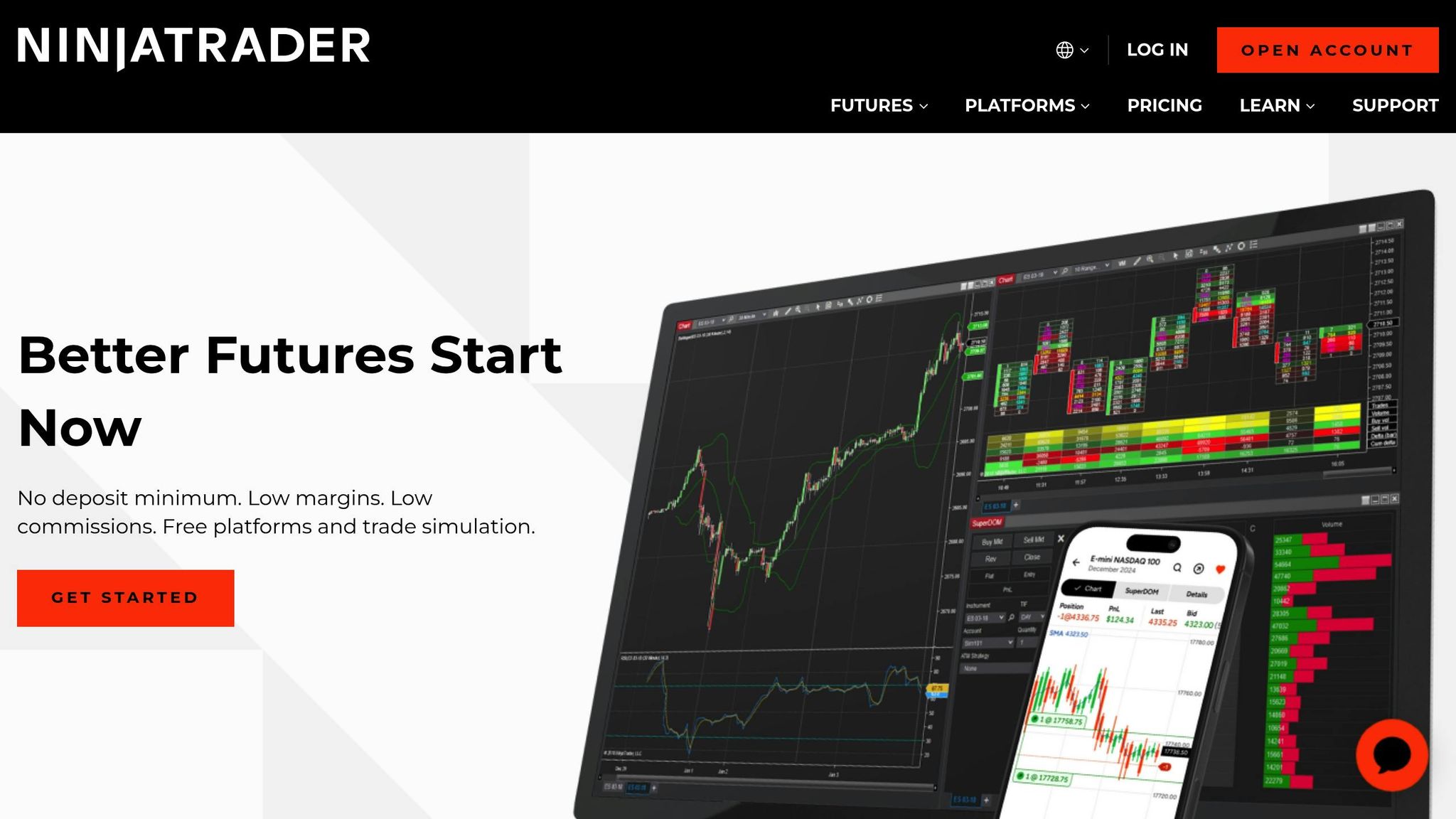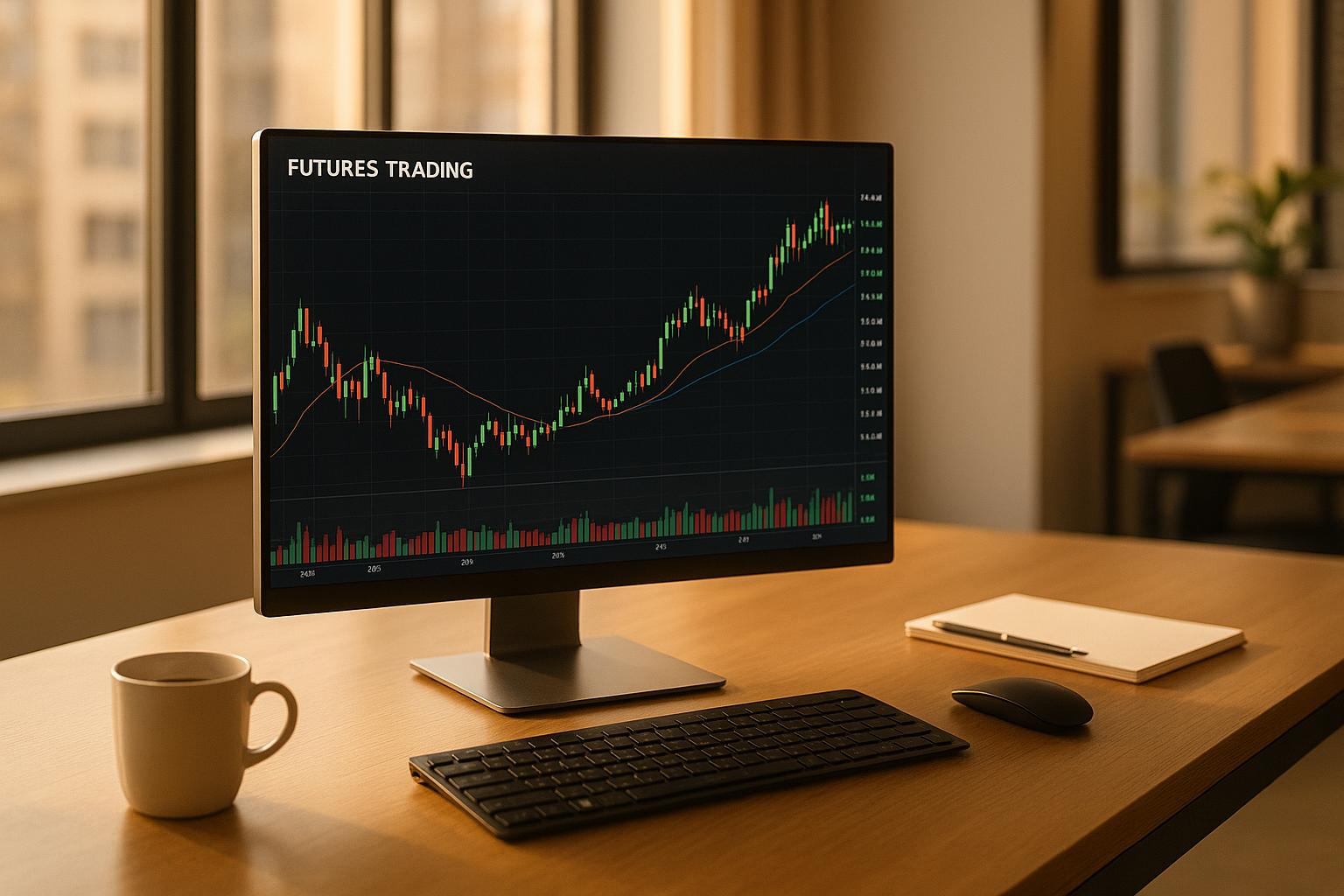Futures trading is a natural fit for prop firms due to its combination of liquidity, leverage, and cost efficiency. These features align perfectly with the goals of proprietary trading firms, which rely on their own capital to generate profits. Here's why futures trading works so well:
- High Liquidity: Futures markets handle massive trading volumes, ensuring quick order execution with minimal price impact, even during volatile periods.
- Leverage: Traders can control large positions with a small initial margin, maximizing potential returns while using less capital.
- Low Costs: Futures trading often involves lower transaction fees compared to other markets, which adds to profitability for both firms and traders.
- Risk Management: Standardized contracts and advanced trading platforms enable strict risk controls, safeguarding firm capital.
Prop firms also use futures markets to train and evaluate traders, leveraging simulated environments, performance metrics, and educational resources. This structured approach helps identify skilled traders while minimizing risk.
Futures trading offers prop firms a scalable, efficient way to manage capital, support traders, and achieve consistent returns.
Intro To Futures Trading & Prop Firms
Main Benefits of Futures Trading for Prop Firms
Futures trading offers prop firms distinct advantages that enhance their operations and support their trading strategies. Key benefits include high liquidity, access to leverage, and cost efficiency, all of which play a crucial role in the success of prop trading firms.
High Liquidity for Seamless Trade Execution
Major futures markets are known for their deep liquidity, which ensures smooth trade execution for prop firms. High liquidity means orders are filled quickly, with minimal slippage and narrow bid-ask spreads - even during periods of market volatility. This is especially important when firms handle large positions across multiple traders.
Take the Natural Gas (NG) futures market, for example. It processes an average daily volume of around $8.8 billion, compared to the U.S. natural gas ETF (UNG), which averages just $175 million in daily trading volume. This level of liquidity allows prop firms to enter and exit positions efficiently, even during volatile times, minimizing price impact and enabling traders to focus on strategy rather than execution. Key indicators of liquidity include bid-ask spreads, trading volumes, and market depth.
Leverage for Optimized Capital Allocation
Futures trading provides access to leverage, enabling prop firms to make the most of their capital while giving traders significant buying power. Initial margin requirements for futures contracts are typically low, ranging from 3% to 12% of the contract’s notional value. This allows traders to control large positions with minimal upfront capital. Leverage ratios in futures markets can range from 10:1 to over 100:1, depending on the contract and broker. For example, day trading margins for popular futures contracts can be as low as $50.
Leverage allows traders to control large positions with relatively small deposits.
This efficiency benefits both prop firms and their traders. Firms can allocate their capital across multiple strategies, while traders gain access to significant buying power without risking personal funds. Leverage also enables diversification, allowing firms to spread risk across various markets and instruments, from commodities to financial indices. This approach reduces concentration risk and increases the potential for consistent returns.
| Contract Value | Margin Required | Leverage Ratio |
|---|---|---|
| $25,000 | $2,500 | 10:1 |
| $50,000 | $2,500 | 20:1 |
| $100,000 | $5,000 | 20:1 |
While leverage amplifies potential gains, it also increases exposure to risk. This makes robust risk management systems essential to ensure that leverage is used effectively and responsibly.
Lower Trading Costs
The cost-effectiveness of futures trading is another key advantage for prop firms, particularly those using high-frequency or large-scale trading strategies. Lower transaction costs directly impact profitability when executing hundreds or thousands of trades across multiple accounts. Futures markets often offer competitive commission rates, such as Optimus Futures’ $0.25 per side for micro futures and $0.75 per side for standard contracts.
In addition to lower fees, futures markets provide other benefits, including transparent pricing, 24-hour trading, unrestricted shorting, and tax advantages. These factors make futures trading an attractive option for prop firms aiming to maintain cost efficiency. By keeping costs low, firms can focus on offering favorable profit splits to their traders rather than relying on excessive fees. Additionally, this cost efficiency helps traders transition more smoothly to managing their own capital when they move from prop trading to independent trading.
How Prop Firms Use Futures Trading for Trader Training
Prop firms turn to futures trading as a structured way to train traders. By using simulated environments, performance evaluations, and focused educational resources, they create a system where traders can develop skills while keeping risks in check. This approach provides a safe space for learning and growth before stepping into live markets.
Practice Trading for Skill Building
Simulated trading platforms are a key tool for building trading expertise. These platforms allow traders to test strategies under various market conditions without putting real money on the line. Traders can experiment with different methods, better understand market behavior, and get comfortable with trading tools. For firms, these simulations also serve as a way to evaluate a trader's ability to manage risk and follow trading rules. Some firms even use a two-step evaluation process to identify candidates who consistently perform well.
Platforms like For Traders provide customizable challenges that replicate real-world market scenarios. Traders work with virtual capital, aiming to hit profit targets while staying within drawdown limits. This setup helps them build skills at their own pace while preparing for real trading environments.
How Prop Firms Measure Trader Performance
To evaluate traders, prop firms rely on metrics like Profit and Loss (P&L), Sharpe Ratio, Maximum Drawdown, Average Trade Duration, Win Rate, and Risk-Adjusted Return. These indicators help assess a trader's profitability, risk management, and consistency. Interestingly, only about 5%-10% of participants meet the strict evaluation standards, and roughly 20% of funded traders maintain their performance over time. Firms often require traders to meet specific profit goals during staged evaluations, all while keeping daily losses and overall drawdowns within predefined limits.
In addition to these performance benchmarks, ongoing education and support play a crucial role in preparing traders for live markets.
Training Resources and Community Support
High-quality training resources and a supportive community are essential for helping traders succeed. Prop firms go beyond teaching technical skills - they also focus on psychological preparation and behavioral assessments to help traders make sound decisions under pressure. Many simulated trading platforms include community features, where traders can share strategies, exchange feedback, and even participate in friendly competitions to keep learning engaging.
For Traders stands out by offering a complete package: an extensive video course, active community support through Discord, and in-person events that connect traders. These resources aim to boost both confidence and competence, ensuring traders are ready for the challenges of live trading.
sbb-itb-9de3b6e
Trading Tools and Platforms for Futures in Prop Firms
Prop firms rely on cutting-edge platforms tailored for high-volume trading, strict risk control, and detailed analytics. These tools are the backbone of the strategic edge prop firms maintain in futures trading.
Trading Platforms for Futures
When it comes to futures trading, prop firms often turn to institutional-grade platforms like NinjaTrader and Tradovate.
NinjaTrader is a desktop application that offers extensive customization options and advanced scripting capabilities via NinjaScript. It’s a powerful tool for traders looking to automate strategies and analyze markets in depth. However, it comes with a steep learning curve, and market data requires a separate subscription. While NinjaTrader does have a mobile app, its features are quite basic compared to the robust desktop version.
Tradovate, on the other hand, is a browser-based platform that simplifies access and usability. It supports real-time market data as part of its subscription and offers seamless synchronization across devices. Its user-friendly design makes it easy for traders to get started quickly.
Prop firms often integrate these platforms - or others with similar capabilities - into their systems, selecting the tools that align best with their trading operations.
Risk Management Tools
Risk management is a cornerstone of prop firm operations, and modern tools make this process more efficient and precise. AI-driven systems automatically enforce critical safeguards, such as daily loss limits, position size restrictions, and overall drawdown thresholds. This ensures firm and trader capital remain protected.
For instance, firms like BrightFunded and FX2 Funding have automated systems that monitor and enforce these limits in real time. Another example is Smart Prop Trader, which is known for its trader-friendly risk parameters, including a 4% daily drawdown and an 8% overall drawdown limit.
These systems also provide immediate visual feedback, helping traders avoid breaching limits while maintaining consistency with firm policies.
Performance Tracking and Reports
Prop firms go beyond basic profit and loss metrics by using detailed performance tracking systems to refine trader development and optimize capital allocation. These tools provide insights into metrics like win rates, average holding periods, maximum favorable excursion, and drawdown patterns.
Platforms like Tradervue, TradeZella, and TradesViz are popular among traders for their robust analytics:
- Tradervue is trusted by over 207,623 traders globally. It generates automatic price charts across multiple timeframes, clearly marking buy and sell points for analysis.
- TradeZella boasts over 18,000 users and has journaled more than 19.4 billion trades. It holds a 4.7/5 rating based on 400+ reviews.
- TradesViz offers over 600 charts and statistics tailored for futures traders, along with AI-powered tools that assist with journaling and actionable insights.
These platforms streamline the process of tracking performance, making it easier for firms to identify trader strengths and weaknesses while maintaining high standards.
Comparing NinjaTrader and Tradovate

Here’s a quick breakdown of how NinjaTrader and Tradovate stack up against each other:
| Feature | NinjaTrader | Tradovate |
|---|---|---|
| Installation Requirements | Requires desktop installation | Browser-based, no installation needed |
| Customization | Highly customizable workspaces | Streamlined customization |
| Automation | Advanced scripting with NinjaScript | Basic automation tools |
| Learning Curve | Steep but feature-rich | Moderate, with faster adoption |
| Mobile Trading | Basic mobile app features | Fully synchronized across devices |
| Market Data | Separate subscription required | Included in monthly subscription |
Prop firms prioritize platforms that deliver real-time risk monitoring, reliable data feeds, and seamless integration with their systems. As Jack D. Schwager aptly puts it:
"Risk management is more important than your particular approach in trading the markets. And that's something that retail investors and traders don't really understand."
Why Futures Trading Works Best for Prop Firms
Futures trading stands out as an excellent fit for proprietary (prop) firms due to its liquidity, leverage, and cost-efficiency. These characteristics align perfectly with the business model where firms provide capital to skilled traders and share in the profits they generate.
Liquidity is a major advantage. It ensures that large trades can be executed smoothly, minimizing slippage even during periods of heavy trading. This consistency is crucial for evaluating trader performance across different market conditions.
Leverage amplifies both opportunities and risks, enabling traders to achieve significant returns with relatively small amounts of capital. This setup complements the profit-sharing models commonly used by prop firms, where traders often receive 60% to 90% of the profits they generate. For firms, leverage ensures higher returns on their invested capital while giving traders the chance to showcase their skills effectively.
Low trading costs further enhance profitability for both firms and traders. By maintaining competitive fee structures, prop firms can support high-volume trading strategies without sacrificing profit margins. This cost efficiency also strengthens risk management practices, which are essential for long-term sustainability.
Speaking of risk management, the standardized structure of futures contracts, combined with advanced tools, allows firms to enforce strict controls. These include daily drawdown limits and position sizing restrictions, ensuring that risks are kept in check. As FunderPro aptly puts it:
"If you think that profit is the most important thing in trading, you are wrong. Risk management is." - FunderPro
Additionally, futures trading provides a real-world environment for assessing and training traders. By operating in live market conditions, prop firms can accurately evaluate a trader’s abilities and potential profitability.
Key Takeaways on Futures Trading for Prop Firms
Futures trading offers unmatched scalability and profit potential for prop firms. The proprietary trading market is expected to grow at a compound annual growth rate (CAGR) of over 4% through 2027, reflecting strong momentum within the industry.
This scalability allows firms to accommodate traders with diverse experience levels and capital needs. Whether someone is trading micro contracts or managing large positions across multiple asset classes, futures trading provides the flexibility to support them all.
By focusing on live market conditions, diverse contract options, and stringent risk management, futures trading creates an ideal setup for developing real trading skills. For instance, Apex reported paying an average of $15,265,195 monthly to its traders as of January 2023, with total payouts reaching $517,235,533 since 2022. These numbers highlight the earning potential when futures trading is effectively integrated into a prop firm’s operations.
This approach empowers prop firms to lift capital constraints, maintain strong performance incentives, and maximize trader profitability - all while scaling their business efficiently.
FAQs
How do proprietary trading firms use futures trading to train and evaluate their traders?
Proprietary trading firms use futures trading as a powerful tool to train and evaluate traders by replicating real-market scenarios. These simulations are designed with clear performance metrics, such as profit targets, risk limits, and consistency standards. This setup helps firms gauge a trader's decision-making skills, discipline, and ability to handle risk under pressure.
Futures trading works particularly well for these evaluations due to its high liquidity and standardized contracts, which provide a transparent and efficient platform for assessing skills. Many firms also rely on these assessments to pinpoint top-performing traders, ensuring that only the most capable individuals are entrusted with managing live accounts and aligning with the firm's objectives.
What are the most effective risk management strategies used by prop firms in futures trading?
Prop firms use a mix of strategies to keep risk in check when trading futures. One of their primary methods is setting strict risk limits - this means capping losses on individual trades and limiting daily exposure to avoid major setbacks. They also rely on stop-loss orders, which automatically close trades once losses hit a specified threshold.
Another key tactic is position sizing, where the size of each trade is carefully adjusted based on the account balance and a set percentage of risk. On top of that, firms use adaptive risk management techniques to stay flexible as market conditions shift, ensuring their strategies are always in sync with current risks and opportunities.
By blending these approaches, prop firms stay on top of potential losses while keeping an eye on growth in the fast-paced world of futures trading.
Why is liquidity such an important benefit for prop firms trading futures?
Liquidity plays a key role for proprietary trading firms, enabling them to move in and out of futures positions quickly and efficiently. This helps reduce slippage, which is the gap between the price a trader expects and the actual price at execution. By keeping slippage to a minimum, firms can ensure their trades are executed at the most favorable prices.
High liquidity also strengthens risk management. It allows firms to adjust their positions swiftly in response to market shifts, a critical factor for staying profitable and executing strategies effectively in dynamic, fast-paced markets.


